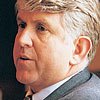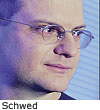20 people who changed the industry
20 people who changed the industry
Reflecting on two decades of tech development and trying to identify 20 of the most influential players is tough, but we skimmed the cream with the help of longtime industry watchers. The result: a list of technologists, savvy business leaders and forward-looking IT executives who made a difference.
NETWORK INFRASTRUCTURE
Len Bosack and Sandy Lerner: Cross-campus Internet workers
They might not have invented the router, as is often believed , but the two Stanford University employees built one heck of a company to exploit it.
The two recognized the multiprotocol router's commercial potential and founded Cisco in late 1984; when they left in 1990 (Lerner was forced out, and Bosack left of his own volition immediately thereafter), the company had grown from an unknown, four-employee start-up to a 250-person, publicly traded industry trend-setter with a market cap of $224 million. Today Cisco remains the router leader, as well as a dominant player in the access, switch, security, storage, VoIP and wireless markets. That market cap? It had grown to more than $120 billion as of late last month.
Desh Deshpande: Framed the future.
 Deshpande launched a data-services revolution in 1991, when he founded switch maker Cascade Communications and propelled the concept of frame relay into the industry's consciousness. Cascade quickly became a dominant network vendor, growing from a one-person start-up to a $500 million company with 900 employees that Ascend Communications acquired in 1997 for $3.7 billion. Thanks in large part to Deshpande's efforts, frame relay has proven to be one of the most successful data services ever, the longtime de facto data communications standard for enterprise networks. After selling Cascade, Deshpande co-founded Sycamore Networks in 1998. Ever the entrepreneur and always the revolutionary, Deshpande this time brought the concept of intelligent optical switching to the foreground.
Deshpande launched a data-services revolution in 1991, when he founded switch maker Cascade Communications and propelled the concept of frame relay into the industry's consciousness. Cascade quickly became a dominant network vendor, growing from a one-person start-up to a $500 million company with 900 employees that Ascend Communications acquired in 1997 for $3.7 billion. Thanks in large part to Deshpande's efforts, frame relay has proven to be one of the most successful data services ever, the longtime de facto data communications standard for enterprise networks. After selling Cascade, Deshpande co-founded Sycamore Networks in 1998. Ever the entrepreneur and always the revolutionary, Deshpande this time brought the concept of intelligent optical switching to the foreground. Bob Metcalfe: Talk about a legacy.
 As a young engineer at Xerox PARC in 1973, Metcalfe invented Ethernet. Little did anyone know the technology, meant to connect local computers, would become synonymous with networking. There's no end in sight for Ethernet's dominance. Now operating at gigabit-plus speeds, it's a choice for even local, metropolitan and wide-area networks. Since his early days at PARC and then 3Com, which he founded in 1979, Metcalfe has been one of the industry's preeminent visionaries. He continues in that role today, helping develop upstart technology companies for Polaris Venture Partners.
As a young engineer at Xerox PARC in 1973, Metcalfe invented Ethernet. Little did anyone know the technology, meant to connect local computers, would become synonymous with networking. There's no end in sight for Ethernet's dominance. Now operating at gigabit-plus speeds, it's a choice for even local, metropolitan and wide-area networks. Since his early days at PARC and then 3Com, which he founded in 1979, Metcalfe has been one of the industry's preeminent visionaries. He continues in that role today, helping develop upstart technology companies for Polaris Venture Partners. Ray Noorda: LAN man
 Noorda took over the helm of struggling Novell in 1982 and in the process of resurrecting the company created the market for network operating systems. His insistence that engineers figure out a way to turn a bunch of disparate PCs into a networked entity turned Novell into the go-to LAN software vendor for years. Noorda's insight - that getting LAN technology entrenched in corporate America would require teams of highly trained and certified individuals - spawned reseller and certification programs still widely imitated today
Noorda took over the helm of struggling Novell in 1982 and in the process of resurrecting the company created the market for network operating systems. His insistence that engineers figure out a way to turn a bunch of disparate PCs into a networked entity turned Novell into the go-to LAN software vendor for years. Noorda's insight - that getting LAN technology entrenched in corporate America would require teams of highly trained and certified individuals - spawned reseller and certification programs still widely imitated todayRadia Perlman: No path uncovered
 Though a prolific inventor to this day, Perlman is perhaps best known for her seminal routing work of the 1980s. Her spanning-tree algorithm, a network staple, made robust, scalable networking a reality. A much-respected educator and collaborator, Perlman today still specializes in sophisticated routing protocols and network security as a distinguished engineer at Sun.
Though a prolific inventor to this day, Perlman is perhaps best known for her seminal routing work of the 1980s. Her spanning-tree algorithm, a network staple, made robust, scalable networking a reality. A much-respected educator and collaborator, Perlman today still specializes in sophisticated routing protocols and network security as a distinguished engineer at Sun. Yakov Rekhter: Today's transport king.
MPLS has come of age, with carriers and large enterprises adopting the protocol in their next-generation networks. Rekhter is known as the father of MPLS, though others, such as renowned routing expert Tony Li, worked on the protocol. Rekhter, who is now a distinguished engineer at Juniper Networks, has several other essential protocols to his credit as well, including the ubiquitous Border Gateway Protocol.
THE INTERNET
Mark Andreessen: Internet revolutionary.
 In 1993, while studying at the University of Illinois and working part time for the National Center for Supercomputing Applications, Andreessen and colleague Eric Bina created a user-friendly, graphical browser. Its first version, NCSA Mosaic for X Window System, was so wildly popular among peers, who had been used to plain text browsers, that the duo quickly created Mosaic browsers for non-Unix systems. Andreessen went on to develop a commercial version, initially called Mosaic Netscape, and the rest is history. Andreessen continues to think big as chairman of Opsware, the data-center automation company he co-founded as Loudcloud in 1999.
In 1993, while studying at the University of Illinois and working part time for the National Center for Supercomputing Applications, Andreessen and colleague Eric Bina created a user-friendly, graphical browser. Its first version, NCSA Mosaic for X Window System, was so wildly popular among peers, who had been used to plain text browsers, that the duo quickly created Mosaic browsers for non-Unix systems. Andreessen went on to develop a commercial version, initially called Mosaic Netscape, and the rest is history. Andreessen continues to think big as chairman of Opsware, the data-center automation company he co-founded as Loudcloud in 1999. Tim Berners-Lee: Weaving the Web
 Berners-Lee dreamed of a universal, easy-to-use information system and forever changed the way people network with his revolutionary World Wide Web. He continues to influence Web standardization and development as director of the World Wide Web Consortium.
Berners-Lee dreamed of a universal, easy-to-use information system and forever changed the way people network with his revolutionary World Wide Web. He continues to influence Web standardization and development as director of the World Wide Web Consortium. Vint Cerf: Net weaver.
 Cerf is widely hailed for his role in defining protocols that made it possible to stitch together stand-alone research networks to form the ARPANet, the precursor of today's Internet. In particular, we have him and fellow pioneering pals like Bob Kahn to thank for the now-ubiquitous IP. Today Cerf is tinkering with IP at the application layer in his position as chief Internet evangelist at Google.
Cerf is widely hailed for his role in defining protocols that made it possible to stitch together stand-alone research networks to form the ARPANet, the precursor of today's Internet. In particular, we have him and fellow pioneering pals like Bob Kahn to thank for the now-ubiquitous IP. Today Cerf is tinkering with IP at the application layer in his position as chief Internet evangelist at Google. Jon Postel: Orchestrating Internet standards.
Postel was another of the many quiet powerhouses behind the early Internet. He's credited with creating a clear, concise template for Internet standards and maintaining that set of unified standards documents. As Network World columnist Jim Kobielus notes, "He was the maestro who coordinated the development of many of the most fundamental open standards, without which the Internet and World Wide Web would never have risen so fast and spread so wide." Postel died in 1998 at the age of 55.
COMPUTING INFRASTRUCTURE
Laurie Bride: Open systems pioneer.
As an enterprise architect at Boeing throughout the 1980s and '90s, Bride had the industry's ear regarding the need to interconnect disparate computing systems. Much of early open systems work traces back to Bride, who authored the TOP portion of the Manufacturing Automation Protocol/Technical Office Protocol and actively worked on and demonstrated the Open Systems Interconnection model and TCP/IP.
Bill Gates: Opening windows the world over.
 Since forging and then ditching his OS/2 partnership with IBM many years ago, Gates has been profoundly influencing the way enterprises develop, deploy and use software. Some might not appreciate his business tactics, but you usually don't get to deliver on your vision by being the nice guy.
Since forging and then ditching his OS/2 partnership with IBM many years ago, Gates has been profoundly influencing the way enterprises develop, deploy and use software. Some might not appreciate his business tactics, but you usually don't get to deliver on your vision by being the nice guy. Lou Gerstner: Leading the way to global services
Although not a technologist by training, this former RJR Nabisco executive left his mark on the industry by realizing sooner than others the importance of services, open standards, the Internet, e-business and Linux, and helped usher in the age of flexible computing and services-oriented architecture development. With that vision, Gerstner turned the lumbering blue giant he ran from 1993 through 2002 into the powerhouse it is today.
Linus Torvalds: Open source's hero
 The open source movement is strong and growing, more so with each passing day, thanks in large part to Torvalds, who published his Linux kernel in 1991 while a university student in Helsinki. Today Torvalds works at the Open Source Development Labs to maintain Linux and accelerate its enterprise adoption.
The open source movement is strong and growing, more so with each passing day, thanks in large part to Torvalds, who published his Linux kernel in 1991 while a university student in Helsinki. Today Torvalds works at the Open Source Development Labs to maintain Linux and accelerate its enterprise adoption. Scott McNealy: Changing mind-sets
 Preaching "the network is the computer" gospel, McNealy opened minds to the idea of the networked environment and seamless connectivity in the late 1980s and early '90s. To follow that, in 1995 McNealy took the industry in a new direction - to the write once/run everywhere world of Java
Preaching "the network is the computer" gospel, McNealy opened minds to the idea of the networked environment and seamless connectivity in the late 1980s and early '90s. To follow that, in 1995 McNealy took the industry in a new direction - to the write once/run everywhere world of JavaTELECOM
Phil Evans: User advocate.
Evans, a president and longtime board member of the International Communications Association, helped shape the telecom industry in the post divestiture era. Widely respected as a network visionary, Evans influenced a generation of telecom and data communications managers in spearheading the ICA's educational efforts in an age of telecom services such as ISDN and frame relay. Evans crafted telecom strategies at a variety of Fortune 500 companies, including Ashland Oil, Dresser Industries, FMC and Occidental Petroleum. He also co-wrote The Network Manager's Handbook.
Harold Greene: Dictated change.
With his infamous 1984 Modified Final Judgment, this federal judge broke up the Bell System and forever changed the telecom industry. He expected competitive local and long-distance service to blossom if AT&T were a long-distance carrier and local services were left to seven regional holding companies. In reality, his decision led to regulatory and legislative wrangling that continues today. One has to wonder what Greene, who died in 2000, would make of today's market in general and the new AT&T in particular.
Ed Whitacre: Telecom's biggest gun.
 Last year Whitacre brought the Bell System breakup full circle when he led SBC's acquisition of AT&T. The move was only natural for the tough-minded, savvy executive who has been reshaping telecom boundaries for years by acquiring fellow regional Bells Pacific Telesis and Ameritech. Now he's at it again, with AT&T's proposed acquisition of BellSouth.
Last year Whitacre brought the Bell System breakup full circle when he led SBC's acquisition of AT&T. The move was only natural for the tough-minded, savvy executive who has been reshaping telecom boundaries for years by acquiring fellow regional Bells Pacific Telesis and Ameritech. Now he's at it again, with AT&T's proposed acquisition of BellSouth. SECURITY
Shlomo Kramer: Father of the firewall
 Wherever there's an enterprise network, firewalls stand guard at its entry points. Some may argue that a garden-variety firewall no longer provides enough enterprise protection, but no one can deny how significant the technology has been for corporate security during the last decade. Kramer and his compadres at Check Point, including CEO Gil Schwed, get credit for inventing the firewall, and Bell researchers Bill Cheswick and Steve Bellovin get the nod for educating the masses in their widely read Firewalls and Internet Security: Repelling the Wily Hacker.
Wherever there's an enterprise network, firewalls stand guard at its entry points. Some may argue that a garden-variety firewall no longer provides enough enterprise protection, but no one can deny how significant the technology has been for corporate security during the last decade. Kramer and his compadres at Check Point, including CEO Gil Schwed, get credit for inventing the firewall, and Bell researchers Bill Cheswick and Steve Bellovin get the nod for educating the masses in their widely read Firewalls and Internet Security: Repelling the Wily Hacker. Taher Elgamal: Encryption go-to guy
 The world of data is a more secure place thanks to Elgamal. While chief scientist at Netscape in the late '90s, this encryption guru pioneered the SSL protocol that is a primary security mechanism for extended enterprises and the Web. Before that, he oversaw the engineering team at RSA Security that developed the industry-standard RSA cryptographic tool kits. He has moved on from Securify, which he founded, and now is founder and chairman of his own company Ektasis in the eCommerce 2.0 market. He serves on the boards of Securify, Phoenix Technologies, Tumbleweed, hifn, Facetime and Vindiciaan.
The world of data is a more secure place thanks to Elgamal. While chief scientist at Netscape in the late '90s, this encryption guru pioneered the SSL protocol that is a primary security mechanism for extended enterprises and the Web. Before that, he oversaw the engineering team at RSA Security that developed the industry-standard RSA cryptographic tool kits. He has moved on from Securify, which he founded, and now is founder and chairman of his own company Ektasis in the eCommerce 2.0 market. He serves on the boards of Securify, Phoenix Technologies, Tumbleweed, hifn, Facetime and Vindiciaan.

0 Comments:
Post a Comment
<< Home